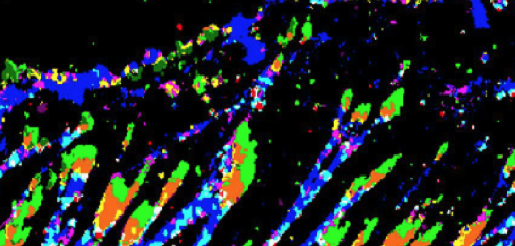
Caco-2 cells labeled for tight junction molecule cingulin (green), actin (red), vinculin (pink) and DNA (blue).

Epithelial cells growing on a patterned adhesive surface with the shape of the Weizmann Institute tree.

Desmosomes in mouse tongue epithelium (by transmission electron microscope).

Porcine aortic endothelial cell, double-labeled for actin (green) and phospho-tyrosine (red).

“Molecular composition map” of focal adhesions and stress fibers.

Myeloma cancer cell responding to shear flow (by scanning electron microscope).
You are here
Scientific Activities ››Mechanosensitivity of integrin adhesions
The mechanosensitivity of integrin adhesions has been demonstrated in many different studies. For example, microtubule disruption induces overall cell contraction and growth of focal adhesions (Bershadsky et al., 1996), whereas local pulling on peripheral focal adhesions results in their growth (Riveline et al., 1999). In addition, traction force microscopy measurements (Balaban et al., 2001; Figure 1) demonstrate that focal adhesions apply pulling stresses of about 5nN/µm2 on the underlying substrate.

Figure 1
Cells plated on a patterned elastomer create distortions. (a) Phase-contrast image of a rat cardiac fibroblast plated on a large grid pattern. The cell creates distortions (arrowheads) by applying force to the elastomer (Young’s modulus = 18 kPa). (b) The same cell as in a 10 min after BDM-induced relaxation. Notice the recovery of the regular grid pattern. Grid pitch = 30 mm. (c) Phase-contrast image of a contracting cardiac myocyte plated on elastomer with embedded photoresist pattern of dots (Young’s modulus = 19 kPa, bar = 6 mm). The dots can be clearly seen even under thick parts of the cell. The arrowheads and the magenta dots underline the pinching action of the contraction on the elastomer. Grid pitch = 2 mm. (d) Relaxed phase.
Any increase of these forces will induce growth of the adhesion sites, while force relaxation will result in their dissociation. Moreover, FRAP measurements indicate that that these force variations also alter the association and dissociation constants of the different components of the adhesion sites, thus affecting the overall composition and stability of the adhesion structures. In turn, this mechanosensitivity of focal adhesions plays a key role in a wide range of cell level responses, ranging from sensing of matrix rigidity (involving different tyrosine kinases) to cell reorientation under cyclic stretching of the underlying matrix (Livne et al., 2014; Figure 2).

Figure 2
Cyclic stretching reorients cells, stress fibers (SFs) and focal adhesions (FAs) along two mirror-image angles. (a-b) Phase-contrast images of REF-52 fibroblast cells on a fibronectin-coated PDMS substrate, before (a) and after (b) 6 hours of cyclic stretching (10% strain at 1.2 Hz), show reorientation from random cell alignments to two, well-defined, mirror-image angles (dashed yellow lines to guide the eye). The largest principal strain (stretch) was applied in the horizontal direction as shown by double sided arrow. (c) SFs (red) and FAs (yellow) reorient to the same well-defined angle as the cell body. (d) Blowup of (c) demonstrates that FAs are co-aligned with the SFs anchored to them.
Further Reading
Balaban, NQ; Schwarz, US; Riveline, D; Goichberg, P; Tzur, G; Sabanay, I; Mahalu, D; Safran, S; Bershadsky, A; Addadi, L; Geiger, B (2001).
Force and focal adhesion assembly: a close relationship studied using elastic micropatterned substrates.
Nature Cell Biology.
3
(5):466-472.


Prager-Khoutorsky, M; Lichtenstein, A; Krishnan, R; Rajendran, K; Mayo, A; Kam, Z; Geiger, B; Bershadsky, AD (2011).
Fibroblast polarization is a matrix-rigidity-dependent process controlled by focal adhesion mechanosensing.
Nature Cell Biology.
13
(12):1457-1465.


- Scientific Activities
- Nano-architecture of adhesion complexes
- Cell-adhesion sensing of the extracellular matrix
- Cancer adhesion and invasion
- Mechanosensitivity of integrin adhesions
- Cell biology of osteoclasts
- Adhesion-mediated signaling
- Platelet adhesion
- Quantitative automated microscopy for high-throughput screening
- Adhesion diversity and the integrin adhesome network
- Adhesion of immune cells
- Heart muscle development
- Publications
- Group Members
- Collaborations
- Screening Projects
- Software
- Galleries
- Research
